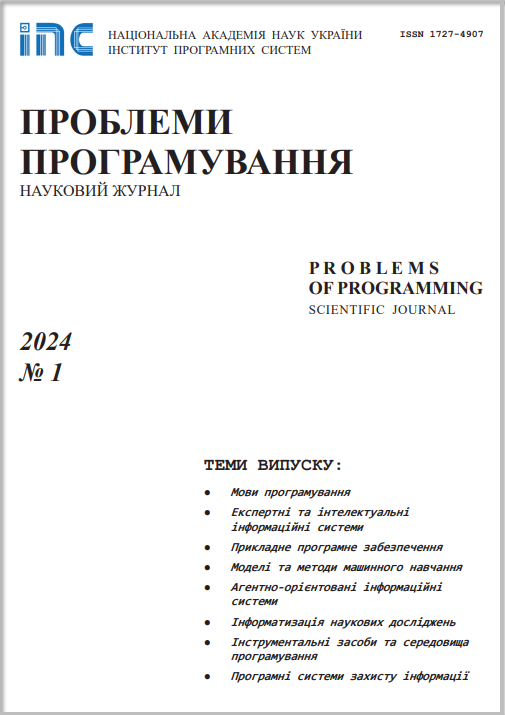Table interpretation of the temporal description logic LTLALC
Abstract
Description logics are widely used to describe and represent knowledge in the Semantic Web. This is a modern and powerful mechanism that provides the possibility of extracting knowledge from already existing ones. Thanks to this, conceptual of subject areas modeling has become one of the fields of application of descriptive logics, taking into account the use of inference mechanisms. Conceptual modeling is used to create databases and knowledge bases. A key issue of the subject area modeling is the ability to monitor the dynamics of changes in the state of the subject area over time. It is necessary to describe not only the current actual state of the database (knowledge bases), but also the background. Temporal descriptive logics are used to solve this problem. They have the same set of algorithmic problems that are presented in conventional descriptive logics, but to them are added questions related to the description of knowledge in time. This refers to the form of time (continuous or discrete), time structure (moments of time, intervals, chains of intervals), time linearity (linear or branched), domain (present, past, future), the concept of “now”, the method of measurement, etc. An urgent task today is to create an algorithm for the temporal interpretation of conventional descriptive logics. That is, to show a way in which temporal descriptive logic can be applied to ordinary descriptive logic. The paper presents an algorithm for temporal interpretation of LTL into ALC. Linear, unbranched time is chosen for the description goal. It is presented in the form of a whole temporal axis with a given linear order on it. Only the future tense is considered. The algorithm contains graphic notations of LTL application in ALC: concepts, concept constructors, roles, role constructors, TBox and ABox. Numerous examples are used to illustrate the application of the algorithm.
Prombles in programming 2022; 3-4: 216-230
Keywords
Full Text:
PDFReferences
CAU A., MOSZKOWSKI B. (2021) Interval Temporal Logic [Online] Available from: http://antonio-cau.co.uk/ITL/ [Accessed: 21 May 2022]
LUTZ C., WOLTER F., AND ZAKHARYASCHEV M. (2008) Temporal description logics: A survey. In 15th International Symposium on Temporal Representation and Reasoning IEEE Computer Society Press, pages 3-14. CrossRef
DONZÉ, A. (2013). On Signal Temporal Logic. RV 2013. [Lecture notes] Legay, A., Bensalem, S. (eds) Runtime Verification. Vol 8174. Springer, Berlin, Heidelberg. CrossRef
MEHRABIAN M., KHAYATIAN M., SHRIVASTAVA A., EIDSON J.C., DERLER P., ANDRADE H.A., LI-BABOUD Y.-S., GRIFFOR E., WEISS M., STANTON K. (2017) Timestamp Temporal Logic (TTL) for Testing the Timing of Cyber-Physical Systems. ACM Transactions on Embedded
Computer Systems 16 p. 169:1 - 169:20 CrossRef
EISNER C., FISMAN D. (2006) A Practical Introduction to PSL [Online] Available from: https://link.springer.com/book/10.1007/978-0-387- 36123-9 [Accessed: 21 May 2022]
WANWEI LIU (2017) Basic Temporal Logic - LTL, CTL, CTL* [Online] Available from: https://data.educoder.net/api/attachments/667?dispo sition=inline [Accessed: 1 June 2022]
FERLEZ J., CLEAVELAND R., MARCUS S. (2017) Bisimulation and Hennessy-Milner Logic for Generalized Synchronization Trees∗ EPTCS 255 pp. 35-50. CrossRef
CS INTRANET (2017) Metric Temporal Logic: Tools and Experiments [Online] Available from: https://cgi.csc.liv.ac.uk/~ullrich/MTL/ [Accessed: 15 June 2022]
BOUYER P., LAROUSSINIE F., MARKEY N., OUAKNINE J., WORREL J. (2017) Timed temporal logics [Online] Available from: https:// hal.archives-ouvertes.fr/hal-01566439/document [Accessed: 1 April 2022] CrossRef
EISNER C., FISMAN D., HAVLICEK J., LUSTIG Y., MCISAAC A., CAMPENHOUT D.V. (2017) Reasoning with Temporal Logic on Truncated Paths [Online] Available from: https://www.cs.bgu.ac.il/~dana/documents/EFHLMV_CAV03_full.pdf [Accessed: 20 May 2022]
DOI: https://doi.org/10.15407/pp2022.03-04.216
Refbacks
- There are currently no refbacks.


